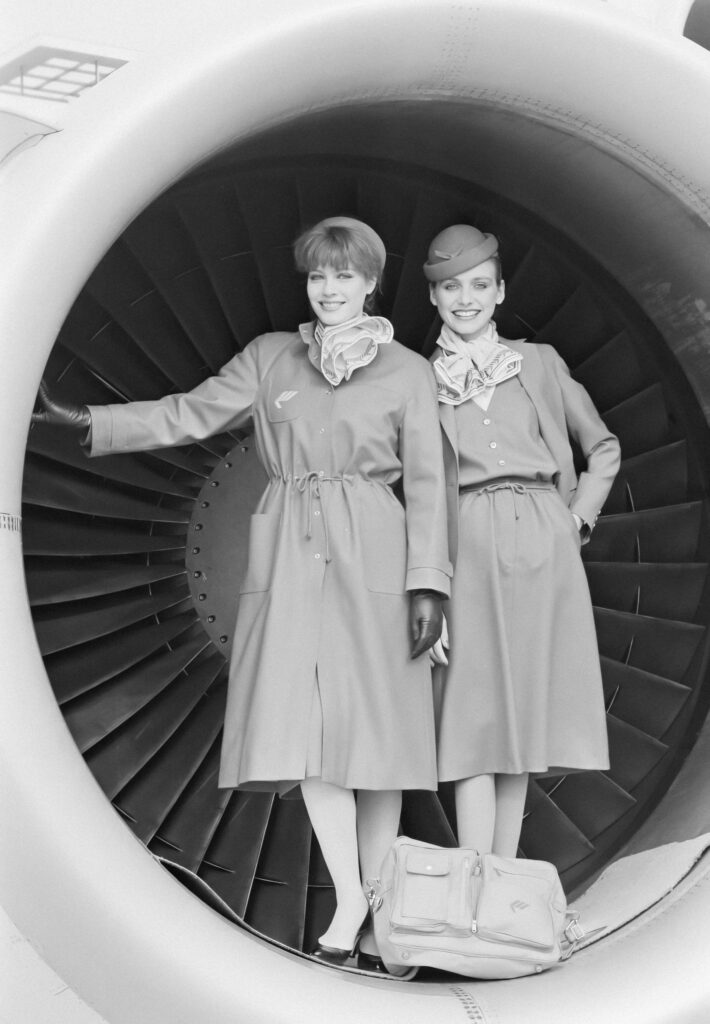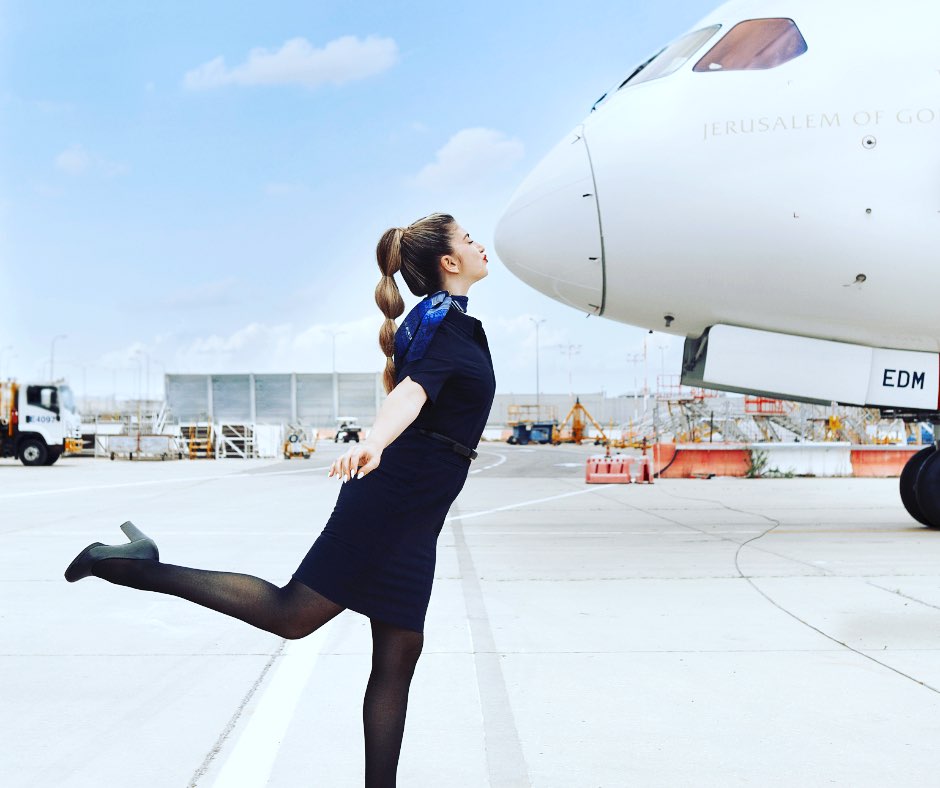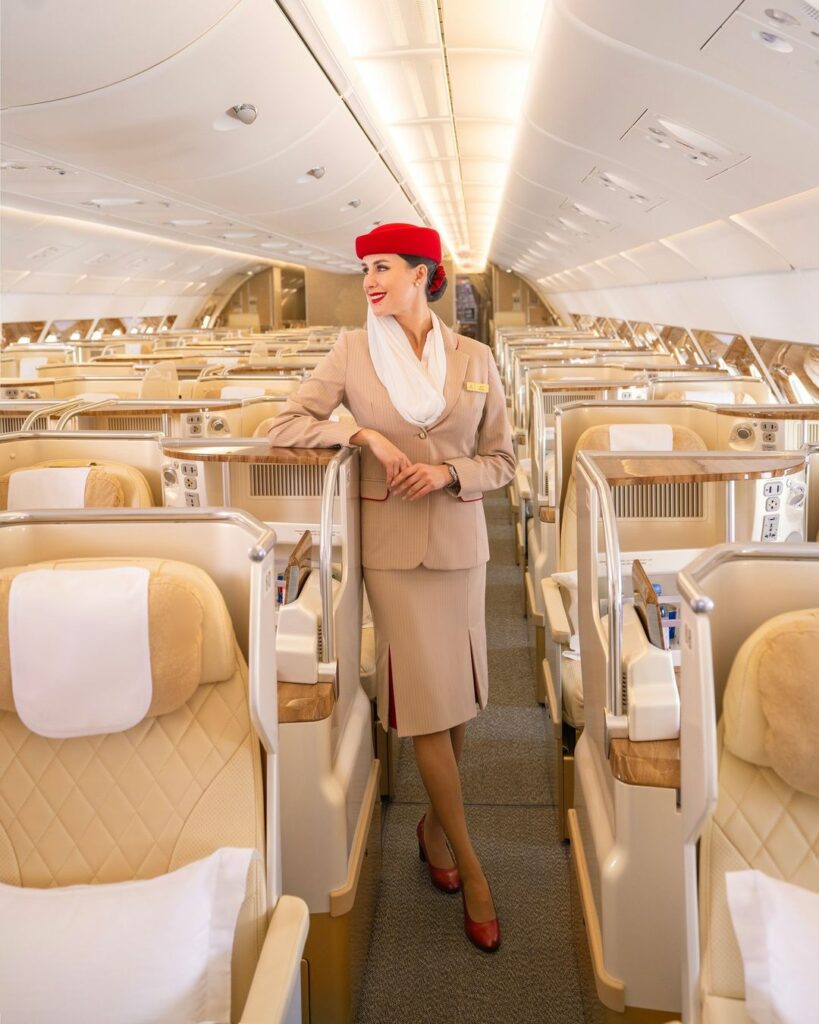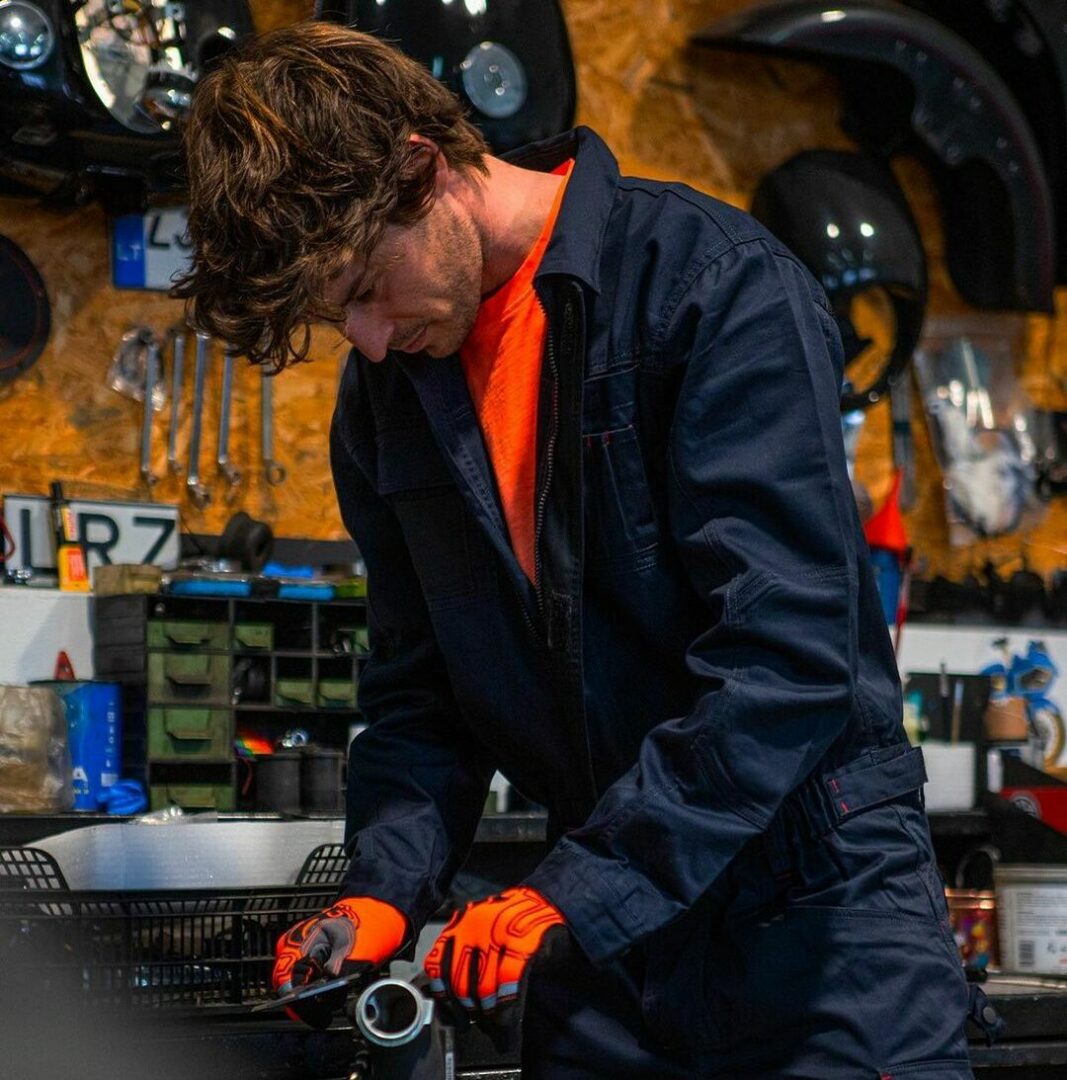The origins and birth of the profession
The origins of flight attendants are closely linked to gender equality and the struggle for civil rights, as the profession evolved during a period of significant social change.
The appearance of the first women in the cabin crew
Flight attendants first appeared in the 1930s, when the first women were introduced into the cabin crew of Boeing Air Transport (now United Airlines). Initially, they were chosen because they could be paid less and used to attract customers through sexist marketing practices. However, in the 1960s and 1970s, both women and men fought for equality and respect in the profession.
The first real hostess is considered Ellen Church, a nurse from Iowa. Thanks to her idea of having nurses board airliners to calm passengers’ fears, she convinced Boeing Air Transport to hire her for a short time. Unfortunately, her career did not last long because of a car accident that forced her to quit her job.
Also in the 1930s, Ellen Church developed the job description and training program for the first female flight attendants, called the “Original Eight.” Before the 1930s, only white men could work in the profession, which had the name “steward.” With the arrival of Ellen Church, women were also introduced, with the title “stewardess.”
The Golden Age of Travel

Photo credit: Nationaal Archief | Unsplash
In the 1950s, the so-called “Golden Age of Travel“, air travel was accessible to all. Women dominated the profession, which was considered elite, but they were still subject to restrictions and lower wages than men. Only young, unmarried, attractive white women could become “hostess“, a term that replaced “stewardesses”. They were in fact considered the faces of the airlines. Until Ruth Carol Taylor challenged these standards in 1958 by becoming the first African American hostess.
In the late 1970s, the terms “steward” and “hostess” were replaced by a more neutral one, “flight attendant,” reflecting social changes and advances in civil rights.
The evolution of flight attendant uniforms
Stewardess uniforms are more than just work clothes; they have become an identity for airlines and a means of differentiation from other brands.
From the roots and early years
Before commercial airlines, flight attendants had to be registered nurses, so the earliest uniforms were basically nurse’s outfits, complete with cape and hood. They often emulated military style to convey a sense of authority and professionalism, much like the attire of the rest of the flight crew.
During World War II, they evolved into more feminine and less conservative versions due to government restrictions on fabrics used for non-military purposes.
The race for differentiation
In the 1950s and 1960s, as more and more competing airlines emerged, they felt the need to differentiate themselves and lend prestige to their brand. They hired prestigious designers and dressed their stewardesses in flashy, colorful uniforms that alluded to the exotic lifestyle they represented. They paved the way for miniskirts, boots, although this led to the exploitation of many female flight attendants for marketing purposes.
All haute couture houses can brag of having had an airline among their clients: Balenciaga, Yves Saint Laurent, Valentino. In 1962, Air France, for example, presented new uniforms by Christian Dior.
The psychedelic fashion of the 1960s
The mid-1960s saw the rise of air travel and the space race. This was the period of cultural upheaval, indeed Braniff International Airways hired publicist Mary Wells Lawrence to redesign its visual identity. In 1965, Lawrence also hired designer Alexander Girard along with fashion designer Emilio Pucci to collaborate with the company.
He called his psychedelic uniform “Supersonic Derby” and it included a printed nylon shirt, tights and a bowler hat. It was all about space and intergalactic travel, in fact it was colorful and futuristic. Pucci also designed a glass helmet inspired by astronauts, called a “rain dome”, to protect their hairstyle. These helmets lasted only a couple of weeks because they were impractical and there was no place to put them during the flight.
The Chanel Era
Thanks to Chanel’s revolutionary fashion, the two-piece suit became the predominant uniform design for flight attendants in the 1970s. Hemlines, depending on the year and the prevailing fashion, were raised and lowered. Airline fashion took note of the growing women’s liberation movement, as evidenced by ensembles that included pants, a first for stewardess attire.
Changes in regulation
Prior to labor laws, these women had to be of a certain height and weight, mainly because of cabin size and restrictions on weight on board based on fuel. With the advent of more sophisticated air transportation, restrictions on employees were reduced. Designers began to create uniforms based on functionality and movement until the present day.
Uniforms have returned to a more conservative, elegant, and professional look. In terms of colors, dark shades such as navy blue became popular.
Appearance and image are still very important factors for many airlines
That said, the situation has become more equitable in terms of discrimination. Some companies are even taking a gender-neutral approach to uniforms.
Tattoos and visible makeup have been allowed for both male and female employees. However, some restrictions remain in the Middle East and Asia.
A breakthrough in freedom of expression
A few years ago, Virgin Atlantic Airways announced that flight attendants will now be free to choose their own uniform based on their gender identity. Pants or skirts will now be assigned based on the wearer’s preferences. This shows how flight attendants’ uniforms still have a close relationship with contemporary fashion.
Flight attendant’s shoes
The footwear worn by a flight crew has undergone significant variations, as has the clothing. In the late 1950s, knee-high boots were opted for as part of a strategy to emphasize the sexuality of aircrew, aiming to highlight female figures.
Fortunately, in the 1960s the style underwent a positive evolution, abandoning the sexualized approach and embracing a more elegant look. In this context, footwear was designed with the business aspect in mind, maintaining moderate-sized heels.
High heels
One notable aspect is the inclusion of high heels, which have been the subject of debate and discussion. In the early days of commercial aviation, flight attendants were predominantly women and had to adhere to strict dress guidelines. These guidelines often included the use of high heels because they added height, poise and a touch of sophistication.

Photo credit: elalisrael
The inclusion of high heels in flight attendant uniforms became synonymous with the glamour and hospitality associated with air travel. High heels not only improved the overall appearance of flight attendants, but also conveyed a sense of authority and professionalism. They were perceived as a symbol of confidence and grace.
From luxury to comfort
With the deregulation of the airline industry in the 1970s, airlines faced increased competition, which led to a shift in focus from luxury to economy. As a result, they began to relax the requirements of their uniforms. This loosening also led to a change in shoe expectations. Some airlines have begun to give flight attendants the option of wearing more comfortable shoes, such as ballet flats or low heels.
Shoes today are often included in an airline’s uniform guideline and are generally standard and professional in style. Some airlines have even eliminated the requirement for heels altogether. With growing awareness of the potential health risks associated with wearing heels for prolonged periods, they have taken steps to prioritize the comfort of their flight attendants.
After all, they are one of the most important components of the uniform, as they protect the feet for hours a day, providing safety against turbulence and possible injury. All while ensuring a professional appearance.
Some airlines provide them; others charge an allowance. The most common standard for cabin crew is a closed toe shoe, which covers the heel, toe and sides of the foot. The heel, if present in the footwear chosen, should be solid to allow stability in turbulent conditions. The maximum heel height is about 7 cm to ensure ease of walking.
Flight attendants: icons of aviation fashion
An essential part of a cabin crew are the flight attendants. We cannot imagine a flight without their reassuring presence, radiating professionalism and style. This job we have seen has a long history that reflects the changing times, both in terms of role and appearance.

Photo credit: Emirates instagram
We can call flight attendants true fashion icons. This role as ambassadors of style is evidenced by their uniforms, true design manifestos that go beyond mere practical purpose.
This deep connection between the profession of flight attendants and the world of fashion is revealed through a close look at the history of their clothing, a history that not only tells the practical evolution of in-flight clothing, but also represents an open window on the broader and more significant transformations of our society.
You may also be interested in the following articles:

U-Power: safety footwear in step with contemporary fashion
U-Power’s incredible story in the context of the “workwear” trend: a limitless influence of style and materials in workwear

FOOTWEAR FOR FARMERS: comfort, safety and resistance are the three fundamental pillars
From the choice of footwear to the importance of socks: how to protect your feet in all outdoor working conditions

Safety footwear focuses on comfort and sustainability
Many innovations were presented at the A+A fair in Dusseldorf, from ultra-light or hyper-comfortable soles to environmentally conscious production systems.













































